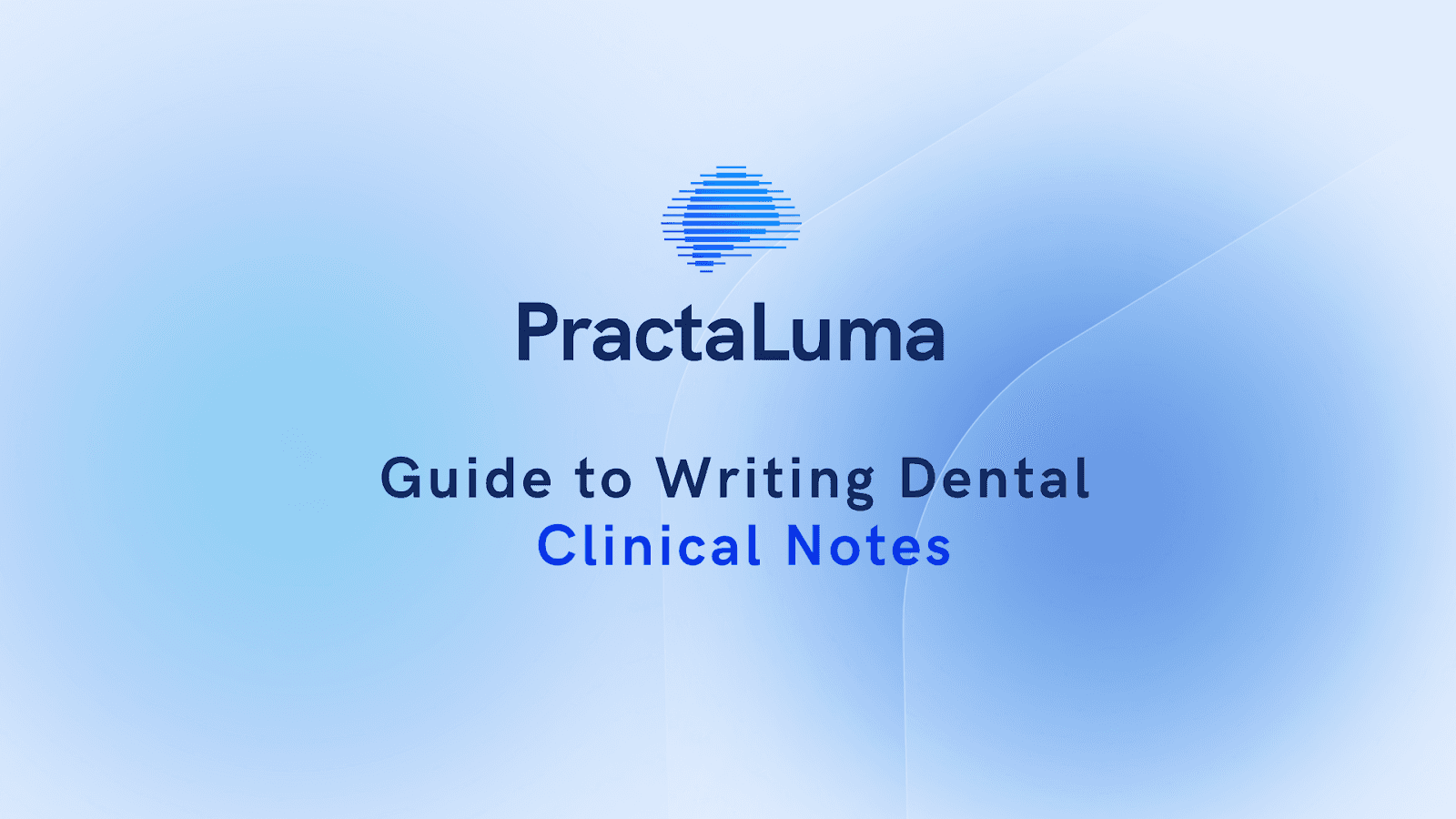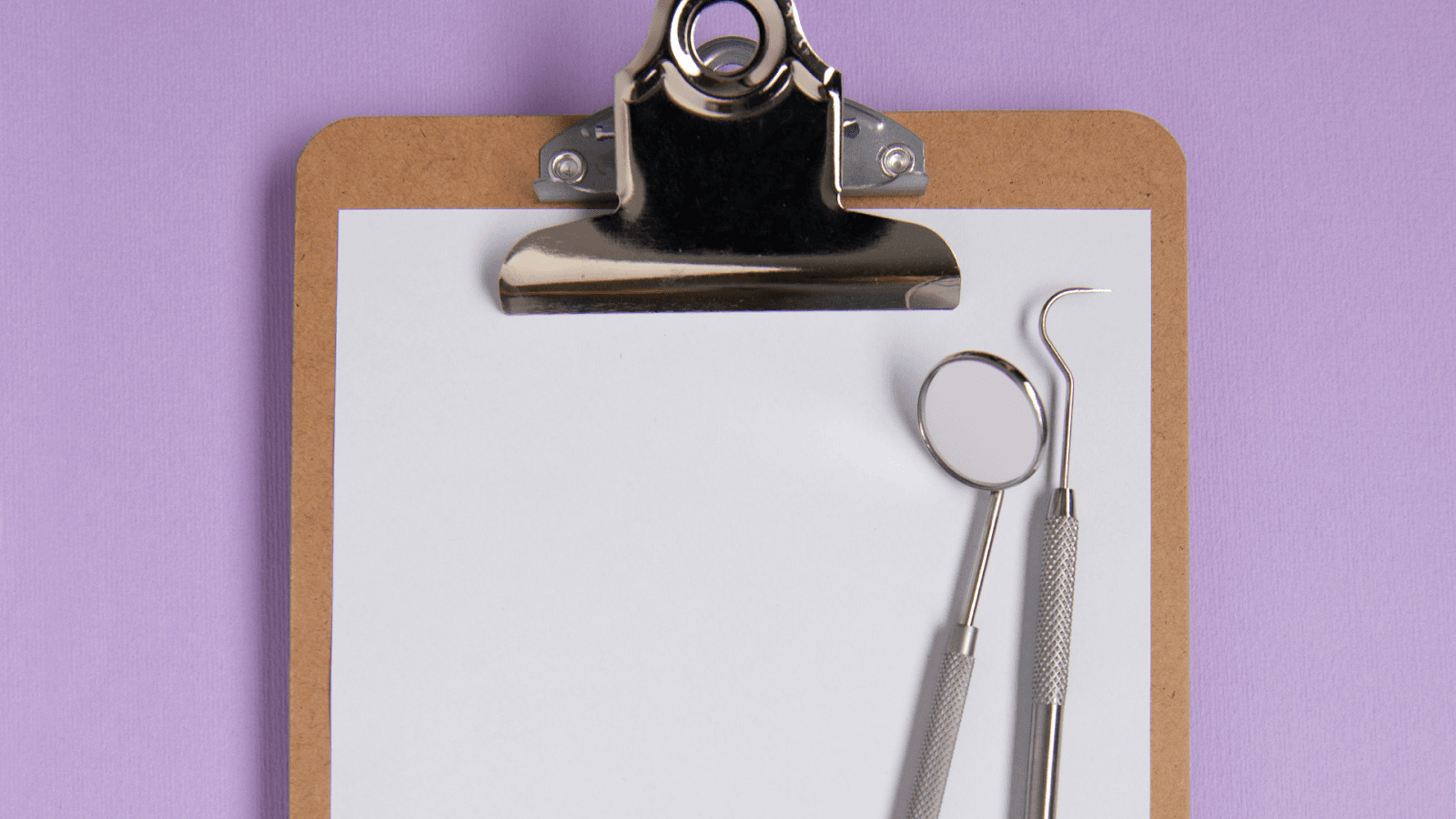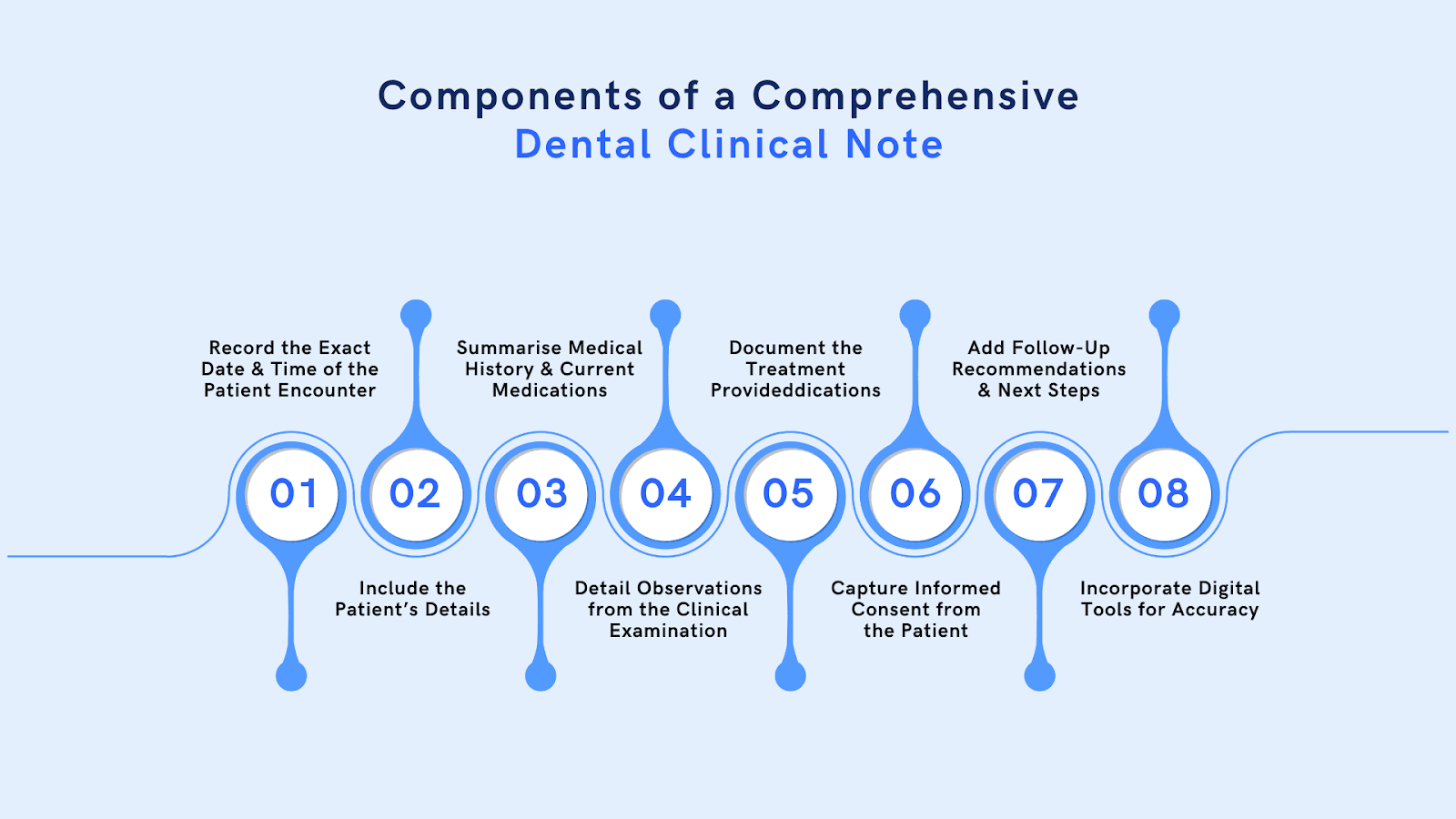
19 March 2025
Guide to Writing Dental Clinical Notes

Have you ever considered what it takes to create an exceptional patient experience in a dental practice?
Beyond skilled practitioners and state-of-the-art equipment, one key factor often goes unnoticed but plays a crucial role: Detailed and well-maintained dental clinical notes. These records form the foundation of every successful dental practice, ensuring patient safety and providing legal protection for practitioners.
Accurate, clear, and concise documentation not only helps provide continuity of care but also reflects the professionalism of your practice. Moreover, clinical notes enhance communication among the dental team, ensuring everyone is on the same page.
In this guide, we’ll explore why dental clinical notes are so important, outline best practices for writing them, and explore how technology and templates can transform the documentation process into a seamless part of your day.
Purpose and Importance of Dental Clinical Notes
Dental clinical notes form the foundation of every dental practice, supporting patient care, streamlining operations, and safeguarding legal compliance. This discussion will delve into their importance through the following key aspects.
1.Ensures Continuity of Care and Supports Legal Requirements
Dental clinical notes are the cornerstone of maintaining a continuous treatment record. They help current and future dental professionals easily understand a patient’s oral health history while ensuring practices meet legal requirements, protecting both patients and practitioners.
2. Facilitates Better Communication Among the Dental Team
Clear, detailed notes keep every dental team member—from hygienists to specialists—on the same page. This ensures smooth communication, consistent care, and a seamless patient experience.
3. Reflects Professionalism and High Standards
Accurate and detailed clinical notes showcase the professionalism of your practice. They highlight your commitment to high standards, ensuring the surgery runs efficiently and meets all industry regulations.
4. Acts as a Legal Record and Future Reference
Well-documented clinical notes provide a strong legal foundation in case of disputes or complaints. They also serve as a valuable reference for future visits, helping deliver consistent and informed patient care.
Having established their importance, let’s explore best practices for writing accurate and professional dental clinical notes.
Best Practices for Writing Dental Clinical Notes
Writing clear and compelling dental clinical notes doesn’t have to be a challenge. Follow these step-by-step practices to ensure your documentation is accurate, professional, and helpful to your team.
1.Update Patient Notes Immediately After Each Appointment
The sooner you document patient details, the more accurate your notes will be. Jot down all relevant information immediately after the appointment while it’s fresh in your mind. This ensures nothing important is forgotten and maintains the integrity of the patient’s record. Waiting too long can lead to incomplete notes or errors that could compromise patient care or legal documentation.
2.Use Clear, Concise and Easy Language
Your clinical notes should be straightforward to understand. Avoid overly technical jargon unless necessary, and use language that other team members can quickly interpret.
3. Follow a Standardised Format
Consistency is key. Adopting a standardised format, such as the SOAP system (Subjective, Objective, Assessment, Plan), ensures every team member can easily navigate the notes. Whether you use SOAP or another format, ensure it includes:
- Subjective observations: Patient’s complaints, symptoms, or concerns.
- Objective findings: Observations from the examination, including X-rays and test results.
- Assessment: Diagnosis or clinical impression.
- Plan: Treatment provided, advice given, and follow-up recommendations.
A consistent structure eliminates confusion and helps create a professional, uniform records system.
4. Document Factual and Objective Information
When documenting clinical notes, stick to the facts and avoid assumptions, subjective opinions, or emotional language. For example, instead of writing, “The patient seemed anxious,” note observable behaviours such as “The patient exhibited fidgeting and asked several questions about the procedure.” This approach ensures the notes remain professional and legally defensible.
5. Include Key Details for Completeness
A well-rounded clinical note should cover the following:
- Date and time of the appointment.
- Patient’s name, age, and relevant personal details.
- Summary of medical and dental history, including allergies and medications.
- Observations from the examination (e.g., gum health, cavities, X-ray findings).
- Treatment provided and materials used.
- Patient’s informed consent for the procedure.
- Recommendations for future care or follow-ups.
Missing details can create gaps in the patient’s history and potentially lead to complications in future treatments.
6.Make Use of Technology and Templates
Leverage clinical software and note templates to streamline your process. These tools save time, reduce errors, and cover all necessary fields—Customise templates to suit your practice’s unique needs while allowing room for additional notes when required. Digital systems, like Practaluma ’s innovative solutions, improve accessibility, enhance data security, and streamline documentation for better efficiency.
7. Review and Update Notes Regularly
Before finalising, review your notes to ensure they are complete and error-free. If updates are required later, add them as amendments with the date and time rather than overwriting the original entries. This will maintain the integrity of the record and ensure transparency.
8. Comply with Legal and Ethical Standards
In Australia, dental practitioners are required to maintain accurate and comprehensive clinical records as part of their professional obligations. Ensure your notes meet the standards set by governing bodies such as the Dental Board of Australia. Inaccurate or incomplete notes can result in legal complications and affect your reputation.
Understanding the need for compliance, let’s explore the key components of a comprehensive dental clinical note.
Components of a Comprehensive Dental Clinical Note

Creating clear and detailed clinical notes is critical to maintaining high standards in your dental surgery. A comprehensive note safeguards patient care, supports legal compliance, and streamlines communication within your team. Here’s what every well-structured dental clinical note should include:
1. Record the Exact Date and Time of the Patient Encounter: Documenting the exact date and time ensures clarity about when treatments occur, aiding patient care and legal compliance. It also helps track progress and manage follow-ups effectively.
2. Include the Patient’s Details: Record the patient’s full name, date of birth, contact information, and a unique identifier to prevent administrative errors and ensure accurate identification.
3. Summarise Medical History and Current Medications: Include an updated summary of medical conditions, allergies, and medications to identify risks and ensure safe, effective treatment.
4. Detail Observations from the Clinical Examination: Provide specific findings, such as the condition of teeth and gums and diagnostic results, to create actionable and thorough records.
5. Document the Treatment Provided: Detail procedures performed, materials used, and immediate outcomes to maintain a complete and accurate record for future reference.
6. Capture Informed Consent from the Patient: Record that the treatment plan, risks, and patient questions were discussed, and consent was obtained to protect the patient and your practice.
7. Add Follow-Up Recommendations and Next Steps: To ensure continuity of care, include aftercare instructions and outline the following steps, such as follow-up visits or referrals.
8. Incorporate Digital Tools for Accuracy: Streamline the process with digital tools like Practaluma ’s Clinical Note Templates, offering auto-fill options, dropdown menus, and secure storage for easy access.
Let’s examine how technology can streamline and enhance the process of dental note-taking.
Utilising Technology for Efficient Note-Taking
In today’s digital age, technology offers powerful tools for efficient note-taking. Apps and devices help you organise, access, and manage notes more effectively, boosting your clinic’s practice.
1. Accuracy & Efficiency
- Digital record-keeping software streamlines note-taking, reducing time spent on administrative tasks.
- Built-in templates, auto-fill options, and dropdown menus ensure consistent and accurate documentation.
- Minimised risk of human error, maintaining a professional standard of care.
2. Cloud-Based Solutions
- Access patient records from anywhere, ensuring continuous care.
- Data is securely stored with encryption and regular backups, reducing the risk of loss or breaches.
- It is ideal for multi-location practices or remote consultations with secure, seamless access.
3. Clinical Note Templates
- Predefined fields for essential information help document patient encounters quickly and accurately.
- Customisable templates cater to specific practice needs while maintaining flexibility for unique cases.
- Saves time and ensures completeness, enhancing both patient care and practice efficiency.
Now, let’s address common challenges in writing dental notes and explore practical solutions to overcome them.
Common Frustrations and Solutions in Writing Dental Notes
Writing dental notes can often feel daunting as you strive to balance detailed documentation with time constraints. However, by addressing common challenges with practical solutions, you can simplify the process while ensuring top-quality records for your practice.
Common Frustrations in Writing Dental Notes:
1. Time Constraints: Practitioners often struggle to find the time to document detailed notes during busy schedules, leading to rushed or incomplete records.
2. Balancing Detail and Conciseness: It can be challenging to ensure thorough and concise notes, primarily when documenting complex cases.
3. Inconsistent Formatting: Without a standardised approach, notes may vary across practitioners, making them harder to interpret.
4. Forgetting Details: Delayed documentation increases the likelihood of omitting important information, impacting the accuracy of records.
Effective Solutions:
1. Use Templates: Standardised templates streamline note-taking with predefined fields for essential information. They promote consistency and minimise errors. These tools enhance efficiency and simplify the documentation process.
2. Schedule Regular Reviews: Set aside time to review and update notes after each appointment or at the end of the day to ensure completeness and accuracy.
3. Train Staff: Equip your team, including dental nurses, with the skills and knowledge to document accurately. Training sessions can improve efficiency and ensure everyone adheres to the same standards.
4. Adopt Digital Tools: Digital solutions, such as cloud-based record systems, enable quick and secure access to notes, saving time and reducing the risk of misplaced information.
5. Prioritise Real-Time Documentation: Document patient details immediately after their appointment to capture all relevant information while it is fresh.
Let’s summarise by emphasising the importance of accurate dental clinical notes and how adopting effective strategies and tools can elevate your practice.
Frequently Asked Questions (FAQs)
1. What are dental clinical notes?
A: Dental clinical notes document a patient's dental care, including medical history, examinations, treatments, and other relevant information.
2. Why are dental clinical notes important?
A: They ensure continuity of care, improve communication between dental professionals, and serve as a legal record in disputes.
3. How often should dental clinical notes be updated?
A: It’s best to update the notes immediately after each patient visit to ensure accuracy and timely documentation.
4. Can I use templates for dental clinical notes?
A: Yes, templates can streamline note-taking, ensuring consistency and saving time. However, they should be customised to meet your practice’s specific needs.
5. How do clinical notes contribute to patient care?
A: Detailed and accurate clinical notes provide essential information for future visits and help dental professionals make informed decisions about ongoing treatment.
Conclusion
Accurate and well-documented dental clinical notes are essential for delivering high-quality care, enhancing communication within your team, and maintaining legal compliance. Adopting best practices, utilising technology, and incorporating customisable templates can turn the challenging task of note-taking into a smooth and efficient process. These steps save time and ensure consistency and professionalism, helping your practice thrive.
Explore Practaluma 's intuitive solutions to improve your clinical documentation offers. With customisable templates, secure cloud-based storage and streamlined workflows, Practaluma empowers dental surgeries to improve accuracy, efficiency, and patient care. Visit Practaluma to discover how its innovative tools can revolutionise your practice today!